If you're looking to grow your market share, you have more than a couple of options available to you. You could first begin by focusing on strengthening your relationship with your customers through outstanding customer service - good business 101. By doing so, you’ll demonstrate to them that they’re more than just a number to you. Or, you could provide shoppers with an experience they can't find elsewhere else.
Standing out amongst the competition and offering your customers something they can only get in your store means more of them will return more regularly. But this can be tricky when every other retailer is trying to do exactly the same thing. Ultimately though (and here’s where things get interesting), you could also spend more of your time, effort and money on a more powerful strategy - product segmentation*.
While the strategies listed above will naturally result in more shoppers visiting your stores - and you should be putting them in place already - product segmentation allows you to hit that next level in the pursuit of retail perfection.
Product segmentation helps you ensure your shoppers become the long-term customers that will keep your business thriving and sustainable. But how can we be so sure that product segmentation will deliver the same, or, better yet, vastly improved results than the standard-issue tactics like improving your marketing?
In retail, where differentiation and variety are critical components for retail longevity, investing in product segmentation will allow you to meet all the product needs and wants of your customers.
This personalisation is even more critical when you consider unforeseen events such as the recent COVID-19 pandemic, which has accelerated change and innovation in the retail industry.
According to the EY Future Consumer Index on behaviour and sentiment, the pandemic has created new consumer segments. These segments are expected to evolve as COVID-19 abates.
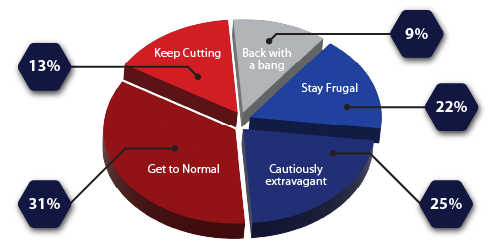
There is also debate about whether it’s time to revisit customer segmentation altogether, a point made in a white paper by Cicero Group, a management consulting firm based in the United States.
While the findings apply to more industries than just retail, it’s still a pertinent idea - there is value in becoming customer-centric. You can apply this thinking to how you approach your product segments too. As with any modern-day approach to category management, it must be shopper-centric.
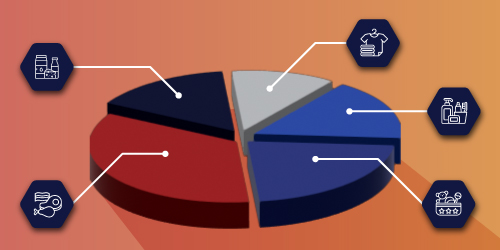
What is product segmentation?
As mentioned above, product segmentation goes a long way to helping you differentiate yourself from your nearest rival. We’ll explain how shortly. But first, what is it exactly?
Firstly, it’s not the same as market segmentation.
Market segmentation refers to the practice of dividing your target market into similar, more manageable groups of people based on common ground.
Product segmentation refers to the action of developing a single product but with minor differences in a bid to cater to various customers which enables you to increase your market share and sales and reduce costs.
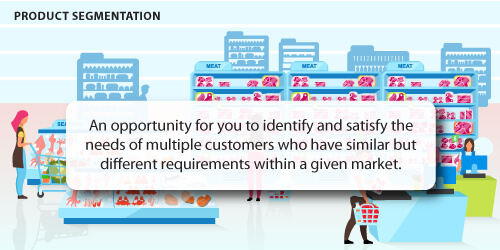
Here’s an example to illustrate that further.
Let’s say you’re a retailer who specialises in paint, hardware and gardening, and so you range a variety of product categories catering specifically to anyone interested in completing DIY projects.
A customer visits your store as they are currently remodelling their garden. As part of that job, they’re looking to install stepping stones and need a suitable mix.
For interest sake, within your Building Materials category, you might stock the following:
- Concrete mix;
- Builder’s mix; and
- Plastering mix.
All of these products have a similar purpose, and so you’d usually segment them together.
In the case of the above customer, they might want to use a concrete mix because it contains stones and provides a stronger result. Meanwhile, another customer who is also looking to install stepping stones, but inside, could choose the builder’s mix as they want a smoother finish.

Regardless of which product each customer chooses, did you notice what happened?
Instead of only meeting the product needs of one customer, you can offer the right product to two. That also means that if both customers think about undertaking a future DIY project, they’ll know you have the products they need.
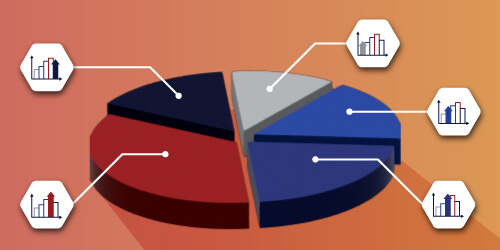
Is product segmentation worth the time and effort?
As you will have read above, product segmentation allows you to cater to multiple customers with different product needs within one category simultaneously. That alone should be a satisfactory answer to the question of whether it’s worth your time and effort.
If that doesn’t convince you, this might: when it comes to segmentation, be that customer, market or product, you can improve your personalisation. And it goes far beyond the retail industry.
49% of participants in a study quoted by Hubspot stated that they purchased something on impulse as it was presented to them with a personalised message.
That said, there is more detail to uncover. In the context of this piece, the detail we’re referring to has to do with its purpose and goal. And there is a good reason for unpacking each. Understanding both allowS you to recognise the real value.
Purpose
First up, is the purpose.
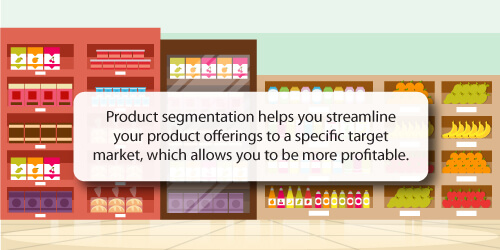
By offering slightly different options to more people, you can distribute the risk of selling high-cost products across different target markets.
Let’s return to the example of the Building Materials category.
Within the category, you wouldn’t only stock one type of concrete mix or builder’s mix because that will limit your ability to increase your sales. It will also show your customers that you either don’t or won’t cater to their needs.
Of course, you do need to be strategic in your approach. You can’t stock everything. Instead, you should look to range various options that meet the individual requirements of your different customers.
One example would be to stock a product that is cheaper (but still has the same or similar value) for your price-sensitive customers. Or, stock a product that is fit for multiple purposes.
It’s worth understanding why your customers buy as well as their buying habits if you’re unsure of where to begin.
Goal
As for the goal, that should be plain to see: it is to sell a high number of products to more people at lower marginal production costs. That’s also one of the many benefits of product segmentation.
Segmenting your products empowers you with the knowledge needed to make better business decisions. As you monitor the sales, you can evaluate the profitability of individual items within the product family to identify opportunities.
These opportunities could include spotting gaps that you need to fill to increase your bottom line and knowing which products are poor performers so that you can discontinue them.
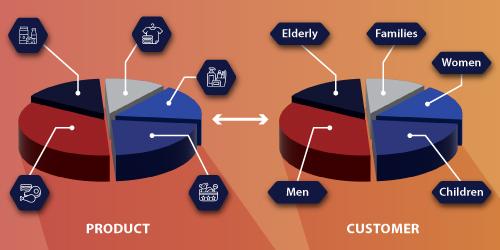
What factors influence product segmentation?
By now, there shouldn't be any doubt about why it's worth investing in product segmentation. But that doesn’t mean that there aren’t any factors that can influence how you approach it.
Recognising and understanding these factors can go a long way to helping you to meet the needs of your various customers.
Factors that influence your approach
In this instance, there are generally two factors that will affect how you approach product segmentation. Both present themselves as questions.
Firstly, what is the product? Secondly, who is the target market?
Product
Let’s again use the retailer example that we’ve used above - you specialise in paint, hardware and gardening. But this time, let’s focus on a different product that caters to DIY projects - wheelbarrows.
Looking at such a product, answering the first question is straightforward.
For a product such as a wheelbarrow, you’d look at the following:
- Size;
- Colour;
- Materials (used to make it); and
- Brand.
Are your customers going to make cement in the wheelbarrow? Then it should be deep and wide and made of metal.
If they are only going to use the wheelbarrow to transport items, it would be shallow and wide and could be made of plastic or wood.
These features all determine classification, which will help you to analyse your market, which determines the product ranging decisions you’ll ultimately make.
Target Market
As for the second question - who is the target market. The answer plays a role in determining what products you stock.
If the majority of shoppers are not builders but rather landscapers, the chances are good that you will sell more products that are fit for the specific needs of a horticulturist.
That doesn’t mean you shouldn’t stock wheelbarrows for those customers who plan on starting a building project at home.
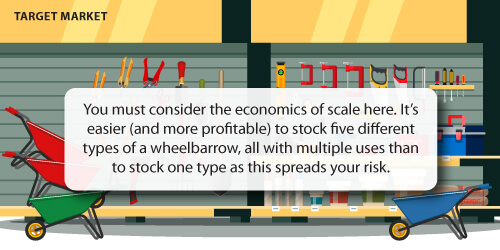
When product segmentation goes wrong
Of course, that doesn’t mean you can’t make a mistake.
Fortunately, it’s easy to pinpoint why you’d fail. That’s because it’s usually down to one reason, which you could break into two halves.
- You don’t spend enough time studying your retail data
- You don’t understand your target market.
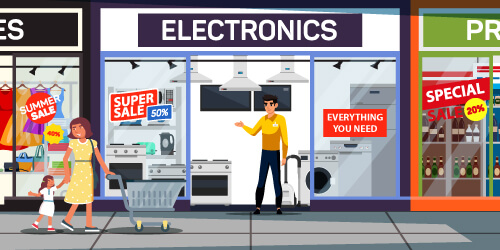
Not studying your retail data
Let’s say, for example, you sell consumer electronics and appliances. And your buyer for the Photography department for some reason decides they want to set you up as a Destination store for DSLR equipment.
You would thus stock every known lens and accessory and camera on the market. However, what could likely end up happening is that it could damage the category in your business. You might even end up with dead stock.
That’s because, in reality, you would never be the store of choice for DSLRs. You’d be better off treating your DSLRs as an image-enhancing sub-category of your Camera category as most professional or amateur photographers would visit a specialist store. Also, a professional would have connections and know where to go for the best equipment.
Not understanding your target market
Alongside that is the failure to study and understand your target market. It happens when you assume that all of your customers are the same.
The result is that you offer one or two products that can meet most of the needs of the majority of your customers.
It’s a scattergun approach to assortment planning and it’s a surefire approach to displeasing shoppers. By failing to understand their product needs and wants, you could find yourself not only targeting the wrong audience but also pricing yourself out of the market.
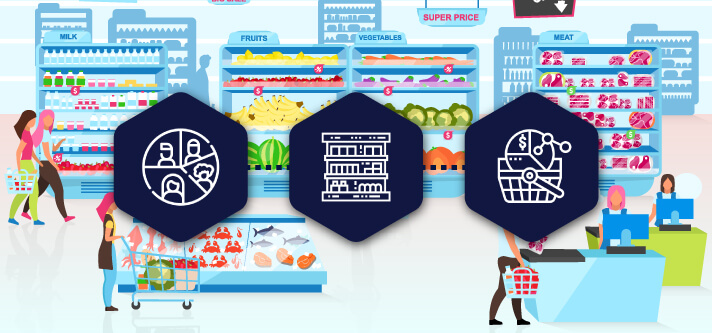
Conclusion
Product segmentation is a way to provide products to all of your customers without devaluing the quality and maximising your sales opportunities. If you want to get serious about it, it’s critical that you understand its purpose and goal.
More than that, it’s about understanding the two key questions that should influence your approach:
- What is the product?
- Who is your target market?
Looking for a category management solution - software or services - that can help you take care of these questions? A category management solution that can ensure you can always provide your customers with the products they want, at any time of the year? Book an exploratory consultation with a DotActiv expert here or browse through our various software editions and services on our online store here.
About the contributors
Chanelle Jacobs joined DotActiv in 2021 as a space planner on various accounts. She has since moved to the role of account manager for JB Active. She has a Bachelor of Consumer Science with Business Management from North-West University.
Elizabeth Maitland joined DotActiv in 2021 as a space planner where she delivered our Planogram Development services to a variety of clients. She has since joined our JB Active account as a category planner. She has a Bachelor of Arts in Fashion Media from STADIO's School of Fashion, formerly known as LISOF.
Justine Brown joined DotActiv in mid-2019 as a retail space planner, creating data-driven planograms for Makro's Food and Liquor account. She has a Bachelor of Consumer Science in Hospitality Management from the University of Pretoria.


